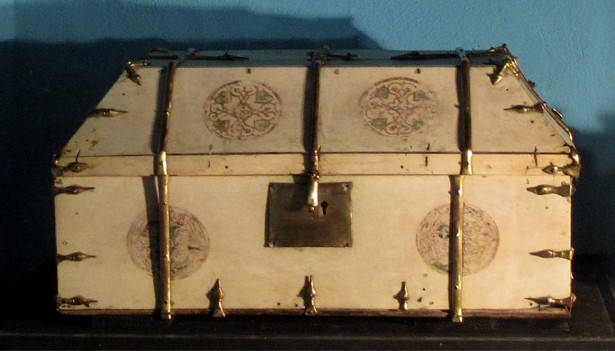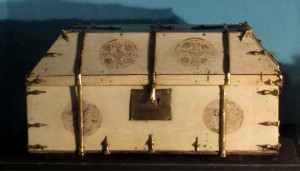“Crypto-relics”

 In an article in in TLS for April 10 of this year (“Traces of the Holy,”) Matthew Bown raises a question about the ‘symbolic economy’ in which some people pay astronomical sums for works of contemporary art that quite clearly have little or no value in terms of materials, craft, or content. He does not ultimately explain the reason, but rather pursues an analogy between the way these values are generated and the way the values of religious relics — remains — were established, most memorably in the medieval church. The value of the body parts, clothing, objects associated with a saint depended primarily on authentic proximity to the person when s/he was alive. The casket illustrated above, for example, once contained the relics (bones?) of St. Petroc, a figure active in sixth-century Cornwall. The relics themselves were stolen by a French Abbey, leaving St. Petroc’s church in Bodmin, Cornwall, with the container–not quite so valuable, but still held in high esteem.
In an article in in TLS for April 10 of this year (“Traces of the Holy,”) Matthew Bown raises a question about the ‘symbolic economy’ in which some people pay astronomical sums for works of contemporary art that quite clearly have little or no value in terms of materials, craft, or content. He does not ultimately explain the reason, but rather pursues an analogy between the way these values are generated and the way the values of religious relics — remains — were established, most memorably in the medieval church. The value of the body parts, clothing, objects associated with a saint depended primarily on authentic proximity to the person when s/he was alive. The casket illustrated above, for example, once contained the relics (bones?) of St. Petroc, a figure active in sixth-century Cornwall. The relics themselves were stolen by a French Abbey, leaving St. Petroc’s church in Bodmin, Cornwall, with the container–not quite so valuable, but still held in high esteem.
In the same way, the value of a “crypto-relic,” Bown’s phrase for a work of contemporary art seen in this context, is established through its authentic physical, bodily connection to the artist. It’s not the sort of proposition anyone could prove. But one can provisionally adopt it, and ask whether it helps–to resolve questions or make useful connections or whatever. At least the very old, very tight link between value and secure attribution to a specific artist seems to fit very well. And a comparison with medieval practice does help to illuminate the irrational, obsessive character of monetary value in contemporary art. What common ground could there be? Now as then, it is easier to cling to a potentially quantifiable and so verifiable measure, such as closeness a specific body (however dubious) or the current monetary value of materials than to actually establish values of one’s own.


